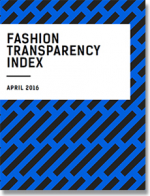Fashion Transparency Index
The first edition of the Fashion Transparency Index includes 40 of the biggest global fashion brands, which we have selected based on annual turnover, and we relied on publicly available financial information to choose this selection of brands and their inclusion was not voluntary.
Following the Rana Plaza garment factory collapse that killed 1,134 people in 2013, the Fashion Revolution team was compelled to demand more transparency from the fashion industry.
To help the public learn where their clothes came from and how they were made, they co-developed the Fashion Transparency Index with Ethical Consumer.
The April 2016 edition of the Index assesses 40 of the top selling global and national brands in the United Kingdom (UK) using a “broad brushstroke approach.” The research was designed to give consumers an overview of how much brands know about their supply chains, what kind of policies they have in place and importantly, how much information they share with the public about their practices and products.
As such, the Index benchmarks companies against current and basic best practice in supply chain transparency, but does not offer in-depth analysis of the content of company policies.
Ratings are given for five key areas: policy and commitment; tracking and traceability; audits and remediation; engagement and collaboration; and governance.
The 40 companies included in the Index were invited to complete a questionnaire, but only 10 replied; the other 30 were scored based on information available on their websites and annual reports, which could have resulted in lower scores. The average score for the 40 brands was 42 percent.
Low ratings (0 to 25 percent) indicate that there is little to no evidence that the company has more than a Code of Conduct in place. Companies that received low ratings include Hermes, Forever 21, Prada, Michael Kors, and Aeropostale, among others. Chanel received the lowest score with just 10 percent.
Middle scores reflect some notable efforts are being made regarding social and environmental issues. Low-middle-rated (26 to 50 percent) brands include Ralph Lauren, Gucci, Victoria’s Secret, Hugo Boss, Burberry, Coach, Lululemon, Abercrombie & Fitch, and more. High-middle-rated (51 to 75 percent) brands include American Eagle, Nike, Gap, adidas, and more.
Only three companies received a ‘top rating’ between 76 and 100 percent: H&M and Inditex, each with 76, and Levi Strauss & Co. with 77, the highest score.
The full report includes deeper analysis of the surveyed companies’ strongest and weakest areas, as well as several positive examples of progress.
What’s Related

Favorites





